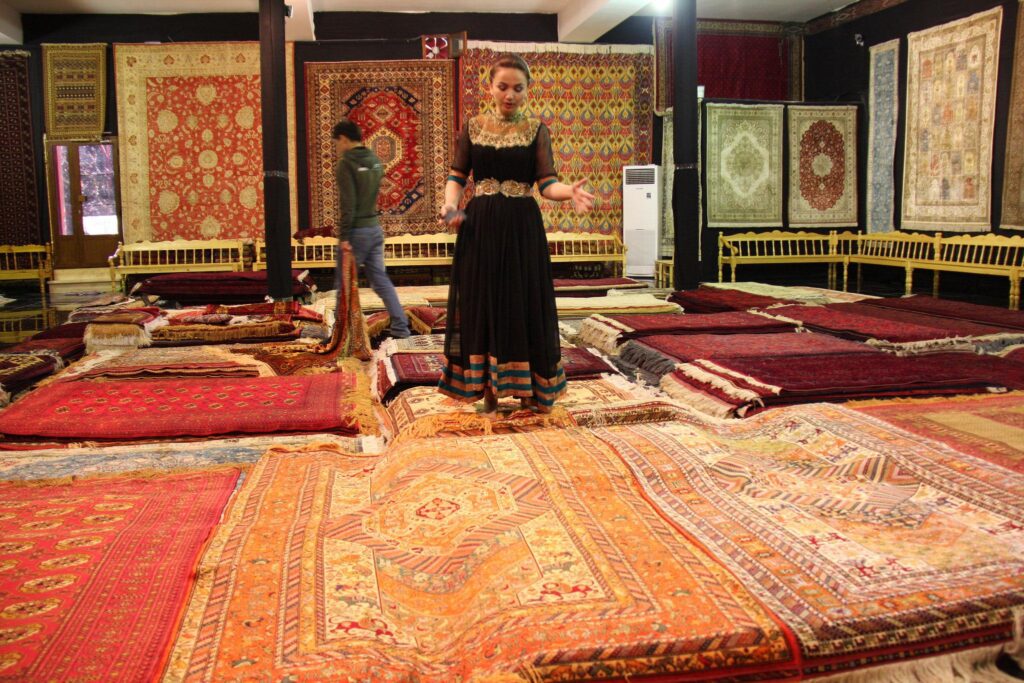Uzbek Carpets: Historical Perspective

Uzbek carpet phenomenon is based on earlier traditions associated with multilingual human collectives that played an important role in the ethno genesis of the Uzbeks. These include residents of agricultural oases: the Bactrians, Sogdians, Khorezmians, and Ferghans as well as representatives of the nomadic steppe world Saka-Massagetian tribes, Tokhars, Ephtalites, Turks, Karluks, Oghuz, and other smaller groups that history records only the names of.
In the early Middle Ages, carpets remained an integral part of everyday life and the rituals of the local population. The last major wave of Turkic-speaking tribes to join the oases of Transoxiana, at the very beginning of the 16th century, was the Dashti-Kipchaks, with whom the ethnonym “Uzbek” spread throughout the region. One of the components of this tribal association, the Uzbek Kungrats, is now the main bearer of the authentic carpet tradition in Uzbekistan.
Central Asian carpets fall into two basic groups, reflecting two definable artistic traditions. First are the carpets of the Turkic nomadic peoples of western and northern Turkestan, like the Turkmen and the Kazakhs, who developed a broad range of carpet objects, from tent bands and door surrounds to camel trappings and utility bags, to fulfill both decorative and practical functions in the nomadic encampment. The second group consists of commercial carpets woven in towns, mainly in Eastern Turkestan, which are more likely to bear the imprint of artistic influences from China to the southeast and Persia to the southwest.
Traditional carpet-making of the peoples of Uzbekistan is deep seated and abundant. Well known in three categories, they are: short-napped carpets gilam, high pile dzhulkhirs (zhulkhirs), and palas [flatwoven] fabrics, extremely varied in techniques of execution and coloring.

Carpet-making as women’s domestic economic activity was developed in almost each livestock-breeding and livestock-agricultural area. Production of master carpet-makers (gilamchi) or gilambof, gilamduz for the most part satisfactorily met the needs of household use; selling in city markets remaining only a small portion.
A highly developed state of native creative activity led to its being one of the leading employment positions among the artistic crafts of Uzbekistan. The development of women’s handicraft art drew into their life its own beauty, diverse in its own traditional variations, at the same time always retaining local distinctive qualities.
Uzbek Carpets Style
Uzbeks’ carpet decorations, meanwhile, developed according to a different logic. Unlike among the Oghuz and their heirs, the Turkmens, the tradition of using identity markers on the carpets did not spread among the Uzbeks. This was likely due in part to the fact that tribal associations of Dashti-Kipchaks were more flexible: they easily disintegrated, recombined into new combinations, and mixed with each other. Often, the same groups were part of different, larger associations, losing their own names. Many shifted to a sedentary agricultural way of life, completely losing their identity.
Only large tribes namely the Kungrat and the Lakai have preserved the purity of the family to this day. The Kungrat, in particular, followed the concept of nasl busilmasin, ”not to spoil the family,” which was expressed in the rejection of mixed marriages and strict adherence to their own traditions. Even so, they did not use tribal markers in carpets, although they preserved the shamanistic symbols (cosmogonic, totemic, and tamga signs) that are generally important to nomads.
Central Asian carpet-weaving developed along two main lines: the Oghuz-Turkmen line (from the 10thcentury), which was dominated by the use of gels as “emblems” of tribal identification, and the Dashti-Kipchak (Uzbek) line (from the 16th century), the decoration of whose carpets reflected common nomadic worldviews. The two lines had much in common, as they belonged to the same circle of steppe culture, while at the same time preserving some differences in terms of the specific range of products they produced and the manufacturing techniques they deployed.
Bayt-ut-Tiraz of Bukhara
The famous historian Abu Bakr Muhammad ibn Jafar Narshakhi mentioned that in Bukhara there was a large workshop (bayt-ut-tiraz) where, among other things, carpets were woven, apparently with epigraphic decorations (tiraz), as on the surviving Seljuk carpets (from Konya; they date back to the 12th and 13th centuries).
Narshakhi’s information is the only evidence of the existence of the city carpet workshop in Transoxiana—in Central Asia, carpet weaving was still the prerogative of steppe nomads and villagers.
Uzbek Carpet weaving during Khanates
The period of Uzbek khanates has left a significant amount of preserved carpet material. At that time, carpet weaving in Uzbekistan existed as a kind of home craft. Carpets were woven for families’ own needs—chiefly for a bride’s dowry—and were not intended for sale. As a result, Uzbek carpets were less known than their Turkmen and Arab counterparts, some of which were created specifically for sale in the market (Arab bazaar-gilam, Turkmen beshir rugs for sale in Bukhara).
The main Uzbek producers were Uzbek-Turkomans from Nurata; Uzbek ethnic groups of Dashti-Kipchak origin, the largest of which were the Kungrat and the Lakai (Kashkadarya, Surkhandarya); and members of the Uzbek population who had lost their tribal identification (mainly from Samarkand and Jizzakh regions). All of them retained a pastoralist lifestyle.
Carpets are important part of Uzbekistan’s culture
In general, the history of carpet-weaving in Uzbekistan is a history of change in the great styles associated with various ethnic groups and their religious and aesthetic preferences.
Uzbek carpet is a unique cultural monument that was developed over the course of centuries. It has become even more valuable in the context of the disappearance of nomadism as a civilizational phenomenon. The carpet, as an expression of the creative potential of Uzbek tribal groups, is an vital source that sheds light on the history and artistic ideals of the steppe world, which was an important part of Uzbekistan’s cultural heritage.


